Tags
Catholic Church, Christianity, discipleship, Feast of Christ the King, Jesus, Solemnity of Christ the King
Once, when I was assigned in Chattanooga, I had the experience of driving by the regional airport just as Air Force One took off in flight. The president had been in the city promoting an industry and now he was leaving for his next destination. The sight of the plane filled my car window as it was directly in front of me and only a couple of hundred feet above me. Air Force One certainly grabs your attention and this is intentional. The plane is a visual statement about the power and the authority of the President of the United States.
This is what we expect from the ruling powers of our world, whether it be the office of a president, a king or queen, a royal family, a dictator or a tyrant. These authorities want us to look toward them and for the whole world to see in the trappings of their office – whether that be a plane, a crown, a missile launch – a statement of their power and authority. The ruling powers of the world want us to see them. They want our attention, and they want to be noticed.
Our faith and today’s gospel (Mt. 25:31-46) tell us that when Christ returns in glory all nations and peoples will be assembled before him but until that great and final day, our humble king wants us to turn our attention elsewhere. Our Lord wants us to look upon our brothers and sisters in need. Jesus wants us to see the least ones. Both those persons judged righteous and those persons judged unrighteous in today’s gospel ask the same question, “Lord, when did we see you…” Jesus’ answer is that when we allow ourselves to look upon the one who is hungry, thirsty, the stranger, naked, ill or in prison and then act in compassion we encounter him and we are judged righteous. When we do not allow ourselves to see, when we do not act in compassion then a harsh judgment follows.
It all starts with seeing and Jesus proclaims the importance of being willing to see the other, especially the least among us, throughout his ministry.
In the midst of the crowded Temple with people moving back and forth and all sorts of commotion, we are told that Jesus spotted the poor widow giving not from her surplus but from her poverty (Lk. 21:1-4). He saw her and he points her out to his disciples who were there present with him, and he points her out to us. Jesus saw her.
Jesus asks Simon the Pharisee (Lk. 7:36-50), “Do you see this woman?” referring to the woman who had come into the dinner party uninvited, a woman seeking mercy who was bathing the feet of Jesus with her tears. Simon did not “see” the woman because in his heart he had already judged her a sinner not worthy of his attention. Jesus forgives the woman her many sins and tells her to then, “go in peace” while it seems Simon and the other guests at table remain locked in their inability to see.
Jesus, in the parable of the rich man and the poor beggar Lazarus (Lk. 16:19-31), tells us that the rich man easily did not see the poor beggar lying at his doorstep and only after they both die does the rich man finally notice Lazarus, now at rest with Abraham, and then it is only to request that Lazarus be sent on an errand for him! The rich man, both in life and then in death, did not “see” Lazarus and this led to his ruin.
Our Lord, who will come again in glory and before whom all the nations will be gathered, is quite clear regarding our pilgrimage through this world and where we should direct our attention – the royal road for entrance into the fullness of the Kingdom of God is found in being willing to see the least among us and to then act in compassion.

